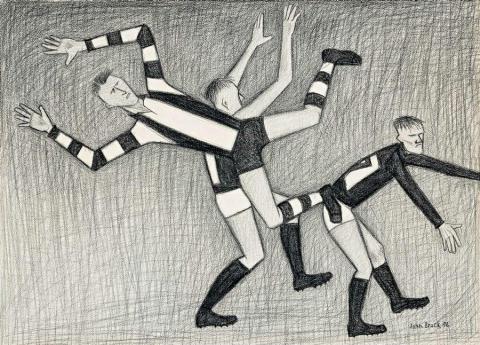FOOTBALLERS, 1956
John Brack
conté on paper
46.0 x 64.5 cm
signed and dated lower right: John Brack 56
Australian Galleries, Melbourne (label attached verso)
Mrs George F. James, USA (acquired from the above July 1958)
Private collection, Maine, USA
Grishin, S., The Art of John Brack: Catalogue raissoné, Oxford University Press, Melbourne, 1990, volume II, p. 48
This unique 1950s drawing of Australian football players constitutes John Brack's sole attempt to represent a sports match. It is an unexpected image within the artist's output, for he was not a sports fan and attended only a single football game. But Brack was interested in the subject intellectually because, according to Helen Brack, her husband 'thought popular sports might give him a lead into human nature.'1
Actually, Melbourne was gripped by sports fever when he developed the drawing in late 1956: the MCG recorded its then greatest attendance when 116,002 people turned out to watch Melbourne beat Collingwood in the Grand Final, the crowd being so vast that the gates were closed at 1.00pm and many fans resorted to climbing on the grandstand roof. Sports excitement was also mounting in the lead up to the Melbourne Olympic Games of November.
Besides being intrigued at the way the Australian imagination seemed gripped by sport, John Brack was fascinated by how a football match is effectively a contemporary form of ritualised combat, with historical roots reaching back to the medieval joust (team uniforms recall courtly livery) and the gladiatorial contest (the football ground is an arena). It is this sense of the ancient buried within the modern that Brack wanted to bring out.2
Inspecting the drawing, while the foremost player leaping for a mark may be wearing a Collingwood uniform, the composition was not intended to depict identifiable sportsmen in a specific match. Instead, it was meant wholely as an image of generic footballers in a moment of intense action. The work is a composite, with Brack deriving the figures from newspaper photographs of several different matches.3 These motifs were flattened and schematised before a featureless hatched background, being arranged in a physically improbable but aesthetically stimulating diagonal configuration. The finished design, which noticeably lacks a ball, both visually invokes the photographs for a popular spot-the-ball competition featured in Melbourne's Sun newspaper that year, and alludes to traditional frieze-like compositions of warring figures from Trajan's Column to the Bayeux Tapestry.4
John Brack did not continue with the football theme, but he did build on ideas introduced in this drawing. The martial frieze effect was reused in his major painting The Chase of 1959; while competitions form the basis for both the Ballroom Dancers series of 1969 and Gymnasts & Ice Skaters series of 1971-75, with the distinctive geometric values of this piece being developed further in the latter works.
1. Helen Brack, conversation with the author, 12 October 2008
2. ibid.
3. The probable sources are sports action photographs featuring Geelong's Clive Brown (Sun, 24 August 1956, p. 21), Melbourne's Denis Cordner (Argus, 3 September 1956, p. 18), Melbourne's Robert Johnson (Argus, 3 September 1956, p. 18) and Collingwood's Laurence Rymer (Herald, 8 September 1956, p. 36) 4. The Sun newspaper ran ten 'Sunball' competitions over March to September 1956
DR CHRISTOPHER HEATHCOTE
